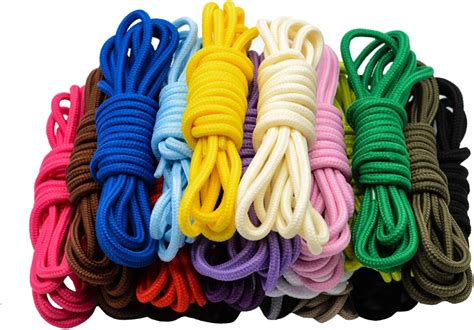Boots Shoelace Buying Guide

When it comes to purchasing boots, one of the most overlooked yet crucial components is the shoelace. The right shoelace can make a significant difference in the overall comfort, durability, and style of your boots. With so many options available in the market, selecting the perfect shoelace for your boots can be a daunting task. In this comprehensive guide, we will delve into the world of boots shoelaces, exploring the different types, materials, and features to consider when making a purchase.
Understanding the Importance of Shoelaces
Before we dive into the nitty-gritty of shoelace selection, it’s essential to understand the significance of shoelaces in the overall boot-wearing experience. Shoelaces play a critical role in providing a secure and comfortable fit, allowing you to customize the tightness and feel of your boots. A good shoelace can also enhance the durability of your boots by providing a snug and even closure, reducing the risk of wear and tear on the boot’s materials.
Types of Shoelaces
There are several types of shoelaces available, each designed to cater to specific needs and preferences. Some of the most common types of shoelaces include:
- Wax-coated shoelaces: These shoelaces are treated with a wax coating that provides a smooth, frictionless surface, making them easy to thread and unthread. Wax-coated shoelaces are ideal for boots with intricate lacing systems or for those who prefer a low-maintenance option.
- Braided shoelaces: Braided shoelaces are made from multiple strands of material that are woven together to create a strong and durable lace. These shoelaces are perfect for boots that require a high level of support and stability, such as hiking or work boots.
- Elastic shoelaces: Elastic shoelaces are designed to provide a stretchy, flexible fit, making them ideal for boots with a relaxed or casual design. These shoelaces are perfect for individuals with mobility issues or those who prefer a comfortable, easy-to-wear option.
Materials and Construction
The material and construction of a shoelace can significantly impact its performance and durability. Some common materials used in shoelace construction include:
- Nylon: Nylon is a popular choice for shoelaces due to its strength, durability, and resistance to abrasion. Nylon shoelaces are often used in work boots and hiking boots where a high level of durability is required.
- Polyester: Polyester is another common material used in shoelace construction, offering a balance of strength, flexibility, and affordability. Polyester shoelaces are often used in casual and fashion boots.
- Cotton: Cotton shoelaces are a popular choice for boots with a more rustic or vintage design. Cotton shoelaces are breathable, soft, and provide a unique, textured look.
Features to Consider
When selecting a shoelace, there are several features to consider, including:
- Length: The length of the shoelace will depend on the type of boot and the desired level of customization. Longer shoelaces provide more flexibility and adjustability, while shorter shoelaces offer a more secure fit.
- Width: The width of the shoelace will impact the overall look and feel of the boot. Thicker shoelaces provide a more rugged, durable appearance, while thinner shoelaces offer a more streamlined, elegant look.
- Tips: The tips of the shoelace can significantly impact the overall functionality and durability of the lace. Metal tips provide a secure, durable option, while plastic tips offer a more affordable, lightweight alternative.
When selecting a shoelace, it's essential to consider the specific needs and requirements of your boots. For example, if you have a pair of hiking boots, you'll want to opt for a durable, water-resistant shoelace that can withstand the demands of outdoor activities.
Comparison of Popular Shoelace Brands
There are several popular shoelace brands available in the market, each offering a unique range of features, materials, and benefits. Some of the most popular shoelace brands include:
| Brand | Material | Length | Width | Tips |
|---|---|---|---|---|
| Nike | Nylon | 72” | 1⁄4” | Metal |
| New Balance | Polyester | 66” | 1⁄2” | Plastic |
| Dr. Martens | Cotton | 60” | 1⁄4” | Metal |

Step-by-Step Guide to Replacing Your Shoelaces
Replacing your shoelaces can seem like a daunting task, but with the right guidance, it can be a straightforward and rewarding process. Here’s a step-by-step guide to replacing your shoelaces:
- Begin by removing the old shoelace from the boot, taking care not to damage the eyelets or lacing system.
- Measure the length of the old shoelace to determine the correct length for the new shoelace.
- Thread the new shoelace through the eyelets, starting from the bottom and working your way up.
- Tighten the shoelace, making sure to maintain an even tension throughout the boot.
- Finish by tying a secure knot to prevent the shoelace from coming undone.
FAQ Section
What is the best material for shoelaces?
+The best material for shoelaces depends on the specific needs and requirements of your boots. Nylon and polyester are popular choices for work boots and hiking boots, while cotton is a popular choice for casual and fashion boots.
How often should I replace my shoelaces?
+The frequency of replacing your shoelaces will depend on the level of wear and tear on the lace. As a general rule, it's recommended to replace your shoelaces every 6-12 months or when you notice signs of fraying or damage.
Can I use any type of shoelace in my boots?
+No, not all shoelaces are compatible with all types of boots. It's essential to choose a shoelace that is specifically designed for your type of boot, taking into account factors such as material, length, and width.
In conclusion, selecting the right shoelace for your boots can seem like a complex task, but with the right guidance, it can be a straightforward and rewarding process. By considering the type, material, and features of the shoelace, you can ensure a secure, comfortable, and durable fit that enhances the overall performance and style of your boots. Remember to replace your shoelaces regularly and choose a shoelace that is specifically designed for your type of boot to get the most out of your footwear investment.


